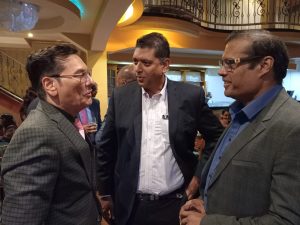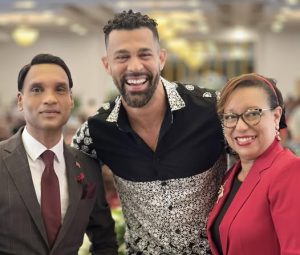
REV John Morton, a missionary of Canada, sympathetically understood the plight of the East Indians in Trinidad and their lack of interest in colonial education at the ward schools.
In January 1869, Morton envisioned a large-scale outreach and formulated “a scheme for the education of Indian children at the expense of the Government” which was presented to Governor Sir Arthur Gordon of Trinidad.
Subsequently, after a cordial agreement with the government, the Presbyterian Church in Canada began financially assisting the construction of primary schools for Indians.
These institutions were initially known as Canadian Mission Indian Schools or CMI schools and later referred to CM schools.
One of the most outstanding and enduring characteristics of the mission was its educational outreach. Schools were established in such outlying villages as Barrackpore, Fyzabad, Rousillac, Santa Cruz, Cumuto, Biche, Plum Road, Cunaripo, Cumuto and Lengua.
One distinct feature of these mission schools was their emergence in very neglected and rural areas. These schools were large one-room wooden buildings and served an important function as it was reported that by 1880, only 590 East Indian children were enrolled in estate schools.
Apart from assistance from the Presbyterian Church in Canada, the planters and government in Trinidad supplemented the resources necessary to continue the educational mission.
The neglect of education was an inherent flaw of the Crown Colony system in which other British West Indian colonies suffered.
The 1891 census estimated that one half of the West Indian population over five years of age was deemed illiterate. And though the expenditure on education in the British West Indies had risen from £95,000 in 1882 to £180,000 in 1896, this was considered inadequate.
The Education Ordinance of 1899 sought to assist the lower class by including a clause which exempted those families who were unable to afford the cost of education and children of indentured immigrants. In the 1890s, one of the Canadian missionaries-Rev Dr Kenneth James Grant, had spearheaded the movement for free education.
Grant believed that the Government should assist those schools with an attendance of at least 150 pupils and that education to the third standard should be free. His concerns did not fall on deaf ears because in 1902, fees were abolished. By 1900, there were 60 CMI schools serving 7,557 East Indian children from an East Indian population of 85,000.
During this period, the mission could boast of possessing 70 pupil teachers, 52 certified teachers and 16 graduates of its training classes.
One of the subtle objectives of education provided by these Canadian Mission schools was to act as an opiate for the masses, thus providing a desired stability for the potentially volatile plantation society.
The conversion from one religion to another, from one culture to another within the education system made the Presbyterian schools appear as agents of deculturalisaton, westernisation and socialisation. However, provision of an English education by the mission schools was compatible with the desired social advancement which some East Indians were seeking.
The Canadian Mission had laid a solid foundation among its primary schools and this would be successfully duplicated among its secondary educational institutions.
On November 22, 1870, Rev Grant (from Scotch Hill, Pictou County in Nova Scotia) and his wife Catherine Copeland (of Merigomish in Nova Scotia) and the Mortons arrived in San Fernando, South Trinidad.
In 1883, Rev Grant held the first school classes under a samaan tree on Carib Street in San Fernando. Among those children attending classes included his son George, Charles Pasea and children of the Mission. (Today this site has Susamachar Presbyterian Church and Grant Memorial Presbyterian School).
Less than a decade later, in 1890, Rev Grant was fortunate to receive approval of the Presbyterian Church for the establishment of a theological training college. Two days after appealing for assistance from the Presbyterian Assembly in Ottawa, in Canada, Rev Grant received half of the total funding from two families in Canada.
The foundation stone of this theological college was initially referred to as the Presbyterian Training
College. In 1959, whilst Rev James F Seunarine was Principal, the Presbyterian Theological College was renamed the St Andrew’s Theological College.
Dr Jerome Teelucksingh is an activist. He initiated the inaugural observances of International Day for the Elimination of Violence Against Men and Boys (January 31) and World Day of the Boy Child (May 16). He has made academic presentations at tertiary institutions including Harvard University and Oxford University.
See other articles by Dr Jerome Teelucksingh on AZP News:
Evolution of Education and Presbyterianism
An Early History of Naparima College
The Glorious City of Port of Spain
Have we Forgotten George Padmore
Nobody Cares about Underachievement
Can we Eradicate Underachievement?
A Quiet Pandemic: Male Underachievement
The Blackest Thing in Slavery wasn’t Slaves
The Importance of Emancipation Day
Tobago’s Working Class in the 1920s, 1930s
Are Humble Caring Fathers Champions?
Influencing West Indian Masculinity
Defining Caribbean Masculinity
Is Monogamy Encouraged in the Caribbean
Naps Girls: From Humble Beginnings to Excellence
US Media Creates Cultural Dependency in the Caribbean
Bloodless Revolution to Save Lives in Developing Countries
The Need for a Social and Moral Revolution
The Law of Supply and Demand in Developing Countries
End the Dependency for Developing Countries
T&T Carnival and the Emperor’s New Clothes
The Influence of Labour on Caribbean Integration
The illusion of political Unity
Presbyterians in Trinidad: Humble Missionaries, Local Workers
Religious Plurality: Curse or Blessing
Caribbean Youth Need Optimism, Patriotism
Rethinking Identities in Caribbean, Latin America
November 19: All Inclusive International Men’s Day
Should International Agencies be Blamed for Unemployment
A Need to Observe Word Unemployment Day
An Ideology for the Trade Union Movement
The Man who Couldn’t be Prime Minister
Social Outburst vs Social Revolution
Challenges of the Men’s Movement
If George Floyd was Denied Parole
The Meaning of Indian Arrival Day in T&T
International Men’s Day – A Way of Life
Wounds that cause school violence
May Day: A Time for Solidarity, Strength
Who Coined the Term ‘Black Power’
The illusion of political Unity
Presbyterians in Trinidad: Humble Missionaries, Local Workers
Religious Plurality: Curse or Blessing
Caribbean Youth Need Optimism, Patriotism
Rethinking Identities in Caribbean, Latin America
November 19: All Inclusive International Men’s Day
Should International Agencies be Blamed for Unemployment
A Need to Observe Word Unemployment Day
An Ideology for the Trade Union Movement
The Man who Couldn’t be Prime Minister
Social Outburst vs Social Revolution
Challenges of the Men’s Movement
If George Floyd was Denied Parole
The Meaning of Indian Arrival Day in T&T
International Men’s Day – A Way of Life
Wounds that cause school violence
May Day: A Time for Solidarity, Strength
Who Coined the Term ‘Black Power’
![]()














